Nicholas Mangan, Termite Economies: Neural Nodes and Root Causes
Vincent Le
There is nothing exclusively human about it: culture emerges from the complex interactions of media, organisms, weather patterns, ecosystems, thought patterns, cities, discourses, fashions, populations, brains, markets, dance nights and bacterial exchanges. There are eco-systems under your fingernails. You live in cultures, and cultures live in you. They are everything and the kitchen sink
— Sadie Plant, ‘The Virtual Complexity of Culture’
Ever since excitedly rummaging through the rock collection of his grandfather who worked at the Geelong Quarries, Nicholas Mangan has been fascinated by the geological formations and subterranean microorganisms lying hidden beneath the earth’s surface. It is only natural that his sculptural practice would see him sublimate his childhood curiosity through the geological materials of which his works are composed. As early as his Untitled (nest) (2004), a ready-made ladder over which drooping nests punctured with sponge-like holes have decided to make themselves at home, Mangan has honed in on the not so firm ground on which we stand, as well as the invisible and inhuman microorganisms capable of constructing and deconstructing it.
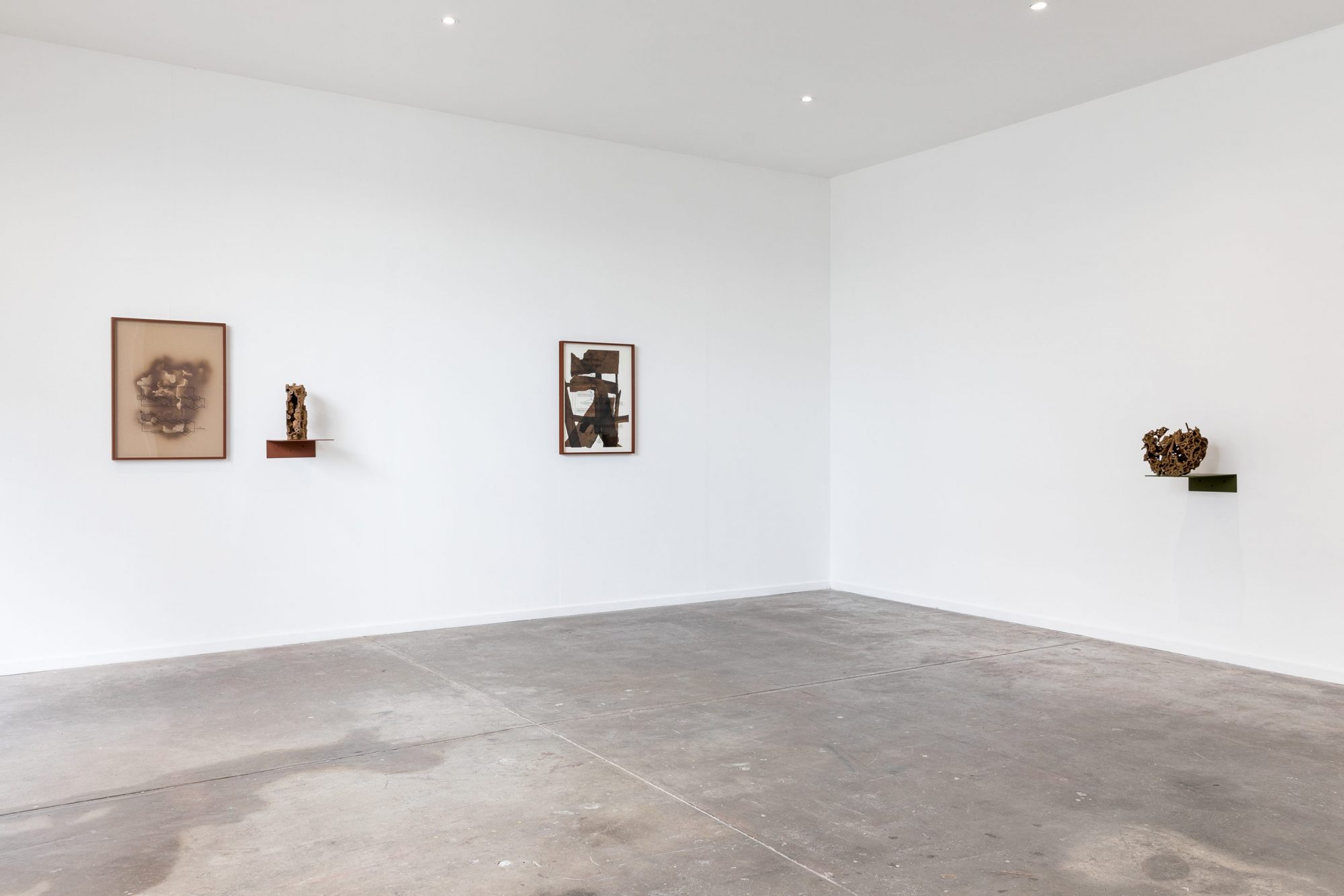
Termite Economies: Neural Nodes and Root Causes is the second exhibition at Sutton Gallery and Sutton Projects in Mangan’s Termite Economies, a series of works that center around the construction of geological, biological, cultural, technical and symbiotic systems based on the microdynamics of termite sociobiology. Termite Economies: Phase One (2019) was inspired by an anecdote about CSIRO scientists’ aborted plan to use termites to hunt down gold hidden deep within the mines. The sculptural works in the first exhibition were conjoined biotechnological twins, quasi-body horror hybrids fusing industrial infrastructure from mining quarries and shafts with tunnel-ridden termite mounds. They were a singular vision of modern empire’s pillaging of nature, swiftly transforming the earth into a real-world blockbuster disaster movie. Neural Nodes and Root Causes shifts focus from industrial capital’s accumulation of the earth into a hyper-exploitative political economy to technocapital and its computer programmers’ and AI neuroengineers’ efforts to model both the human brain and increasingly autonomous machines on the swarm dynamics of termites, among other social insects.

Resting on a steel table under a custom light, Mangan’s Termite Economies (Root Causes) (2019) uses computer models of the sociobiological behavior of termite colonies to produce a 3D printed form akin to a termite mound, which was then hollowed out in the foundry with tunnels and shafts, hidden catacombs and forgotten oubliettes. The dead, grey plastic of the 3D printed form is buried beneath a part-bronze, part-dirt brown finish, giving it the façade of being natural and organic despite being artificially generated. With Neural Nest (slice) (2020), Mangan has turned Sutton Projects into the secret underground lair of a mad scientist as he maps more algorithmic swarms onto a 3D model of a human brain provided by Monash University’s Department of Neuroscience, with its bronze finish giving the brain’s neural cross section of cerebral curves, arteries and veins the simultaneous appearance of copper wires, cables and tubes. On either side of a third 3D printed sculpture, Termite Economies (bite) (2019), there are two digitally printed diagrams of the algorithms behind the computer models, superimposed over 2D renditions of two sculptures—Termite Economies (Phase 1) (2020) and Termite Economies (trophallaxis) (2020). We can thus glimpse how precise algorithmic instructions as to whether to “start”, “determine”, “initialize”, “compile”, “update”, “select”, “move (one time step),”, “begin excavating”, “excavate one pellet”, “carry soil (one time step)”, “begin depositing” and “deposit pellet” can generate something as complex as the 3D printed form of a termite mound, as well as how termite mounds are themselves the products of complex and intelligent, if blind and unconscious, behavior.
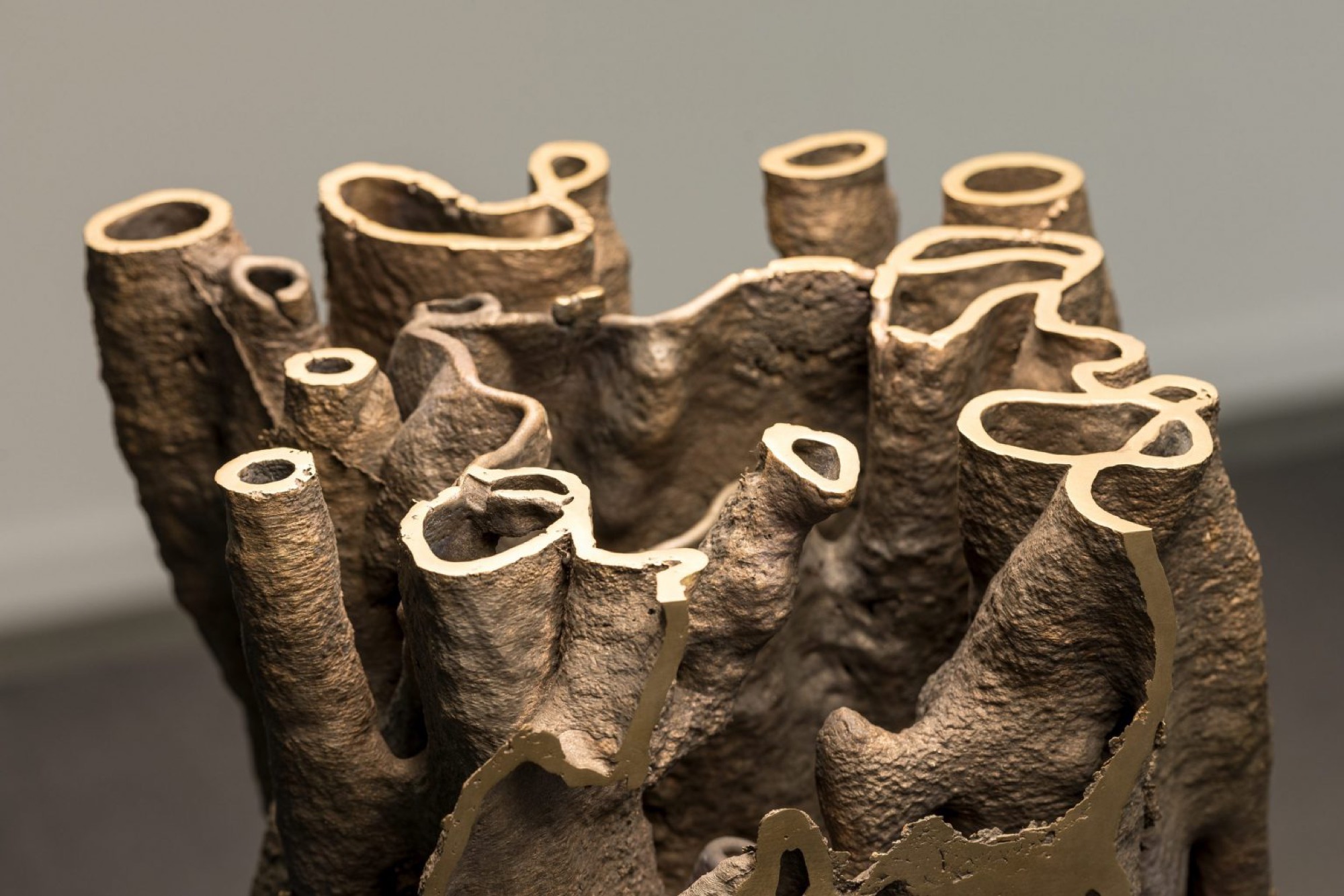
In his vignetted history of modern art, Aisthesis: Scenes from the Aesthetic Regime of Art (2011), philosopher Jacques Rancière doesn’t look to Duchamp’s Fountain (1917) but rather to Hegel bearing witness in 1828 to Spanish Baroque painter Bartolomé Esteban Murillo’s c.1645/46 portrait of lice-ridden beggar boys lounged out in the gutter as the seminal moment when a debased subject devoid of any royal blood, divinity, heroism or historical grandeur was lifted to the status of something to which curious spectators might flock to contemplate in wonder—in short, when an “image of lousy children” became “the presentation of the absolute Idea”. Mangan’s 3D printed termite mazes take this one step further by situating objects in an aesthetic dimension created by nonhuman creepy crawlies widely held in contempt as an invasive species that can only cause great damage—as if to suggest that termites, among other nonsapient organisms, have their own sub(terranean) cultures; their own found objects and ready-mades; their own miniature Murillos and six-legged Duchamps. Artists can create with their antennas, too, trading in paint brushes for pheromone trails. As Amelia Winata wrote in her memo review of Termite Economies (Phase One), “the termites are the star of the show, elevated from the role of destructive pest to tiny miner, while the scientist is nowhere to be seen”. Reconceiving termite colonies as always-already cultural systems with their own evolutionary “art history” of codes and conventions long before humans ever came on the scene to falsely distinguish ourselves from nature, Mangan breaks down the binaries, as well-policed as Australia’s borders, between nature and culture, the real and the artificial, part and whole, as well as between different specialised disciplines, as when sociobiology blurs into art and art blurs into sociobiology.

Treating termites as homunculi-artists harks back to the big daddy of cybernetics Norbert Wiener’s belief around the post-war birth of the modern AI research program that “the physical function of the living individual and the operations of some of the newer communication machines are precisely parallel in their analogous attempts to control entropy through feedback”. According to Wiener, the feedback circuits are the telltale heart of all autonomous agents, be they sentient, sapient or synthetic; they are the means by which a system modifies and regulates itself in response to environmental stimuli in the pursuit of certain goals. Now, it is obviously the case that termites do not rationally think about or conceptually know the mounds and other complex structures they are capable of creating. They are, after all, literally blind, being born without eyes. But as the individual termites in a colony burrow and scout for food, they react to what they encounter by releasing different pheromones that attract or alarm fellow termites to help them gather food or fight off predators. Without any inkling of what they are doing, masses of individual termites can spontaneously come together and collectively forage, reproduce, fight enemies, defend their nest and construct extensive systems of tunnels and shafts to serve as immune systems for their subterranean beating hearts.
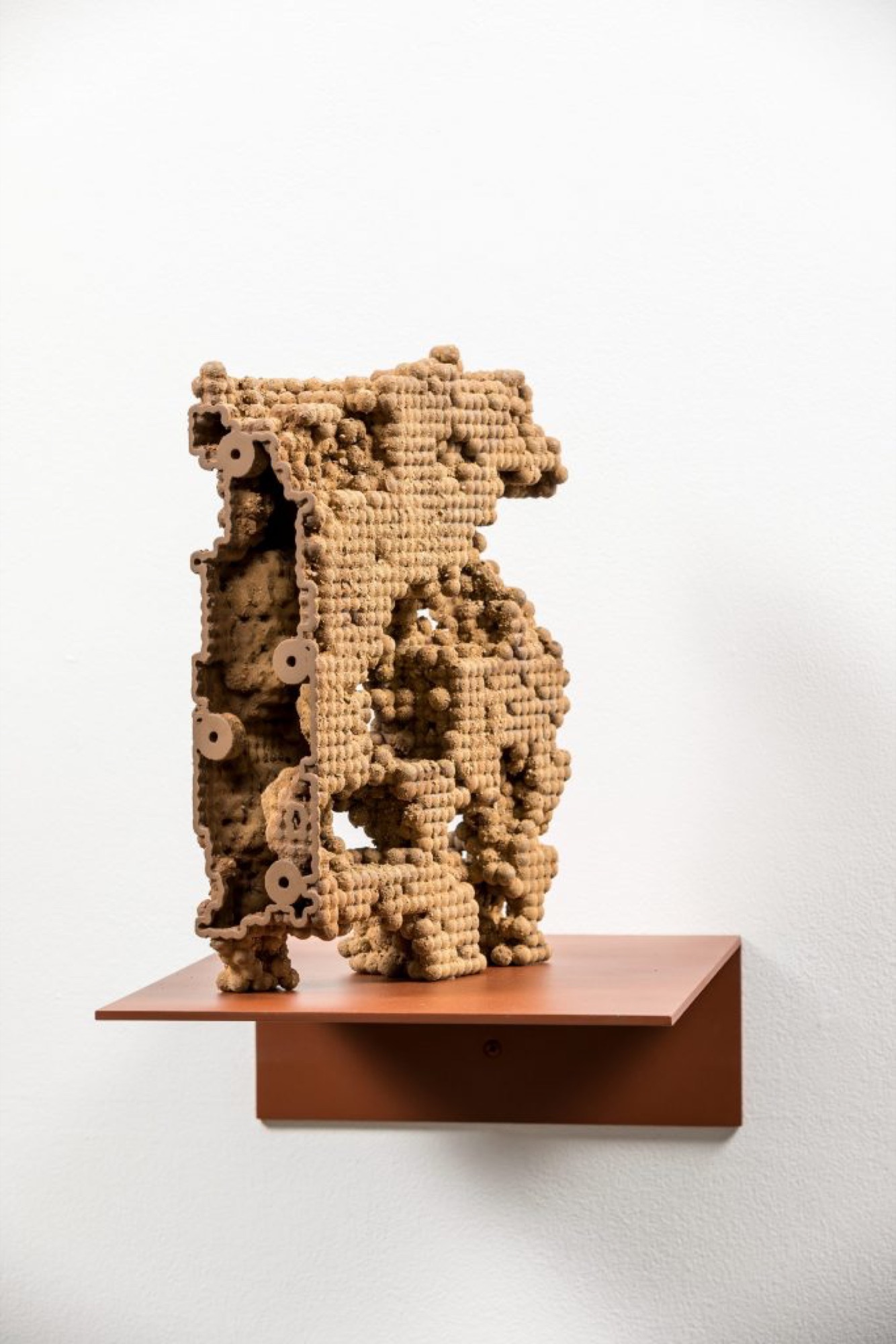
If these idiot savant insect colonies can become a model for artistic productions and cultural systems as Mangan’s sculptural works suggest, it is one in which there is no room for the romantic notion of the lone artistic genius. Termites are only artists in the sense that Socrates describes the great Athenian poets as struck by divine inspiration or demonically possessed into making “many fine utterances” but with “no knowledge about the things they’re saying”, or in the sense that Immanuel Kant’s artistic genius “does not himself know how the ideas for it have entered into his head, nor has he it in his power to invent the like at pleasure, or methodologically, and communicate the same to others”. Kant was right that it is “nature (which) gives the rule to art”, but who would have thought that nature meant the lowly termite? Like art and culture more generally, these crop-devouring pests only ever operate as a superorganism, hive mind or swarm intelligence, a colony of widely distributed simple parts whose decentralised division of labor permits them to self-organise through emergent, complex interactions unknown and irreducible to the headless cogs and wheels of which the system is ultimately composed.
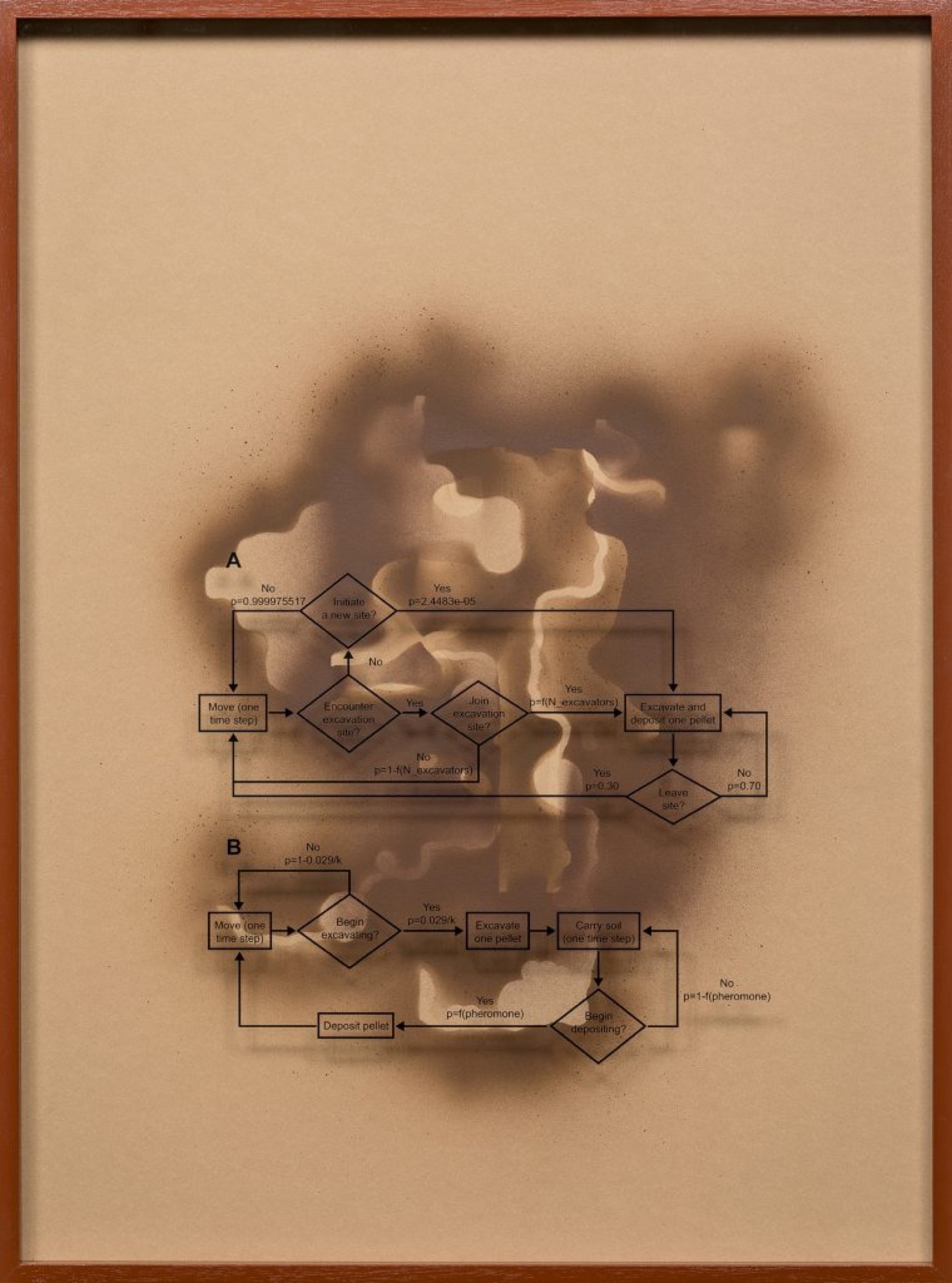
Of course, Mangan’s sculptures are not really termite economies but 3D printed computer models, something that is made clear from the way his sculptures’ soft, organic curves are surgically severed by precise angles and flat, cubed-out sides found nowhere in nature, a kind of mining no less artificial than mining for bitcoin. The dirt brown finish is but a thin veneer for the grey, 3D printed plastic lying like a liquid metal terminator or like John Carpenter’s The Thing behind the familiar face of the living. At first glance, such finishing touches seem to oppose nature once more to its plundering by a purportedly transcendent civilization of tool-bearing primates. But the kinds of algorithms and modern technology that Mangan uses to model and print 3D termite economies actually elide any transcendent, top-down rationality in favor of something more decentralised, emergent and bottom-up—that is, something more akin to an insect colony’s political economy. Whereas good old-fashioned AI’s highly centralised approach required human programmers explicitly encoding by hand everything that computers were to do with a given input in order to achieve a certain output, today’s more advanced algorithms amount to what machine learning expert Pedro Domingos has termed a “technology that builds itself”, that learns and thinks for itself. The key to the connectionist revolution in machine learning is artificial neural nets, simple units akin to neurons in the human brain that receive and adjust the strengths or weights of their connections in the network in response to inputs so as to produce the desired output. Without any prior knowledge about what termites are, for instance, neural net algorithms could learn to identify images containing termites by analysing unlabeled images with and without termites, to then generate identifying characteristics from those images. The neural net would optimise for the output of the correct labelling of images with termites by making trial and error guesses and adjusting the weights of its parameters through backpropagation until it identifies the right images as containing termites, firing 1s when it sees the pests and 0s when it doesn’t. Neural net algorithms rely on harvesting enormous amounts of data, virtual wood and cybercrops, from internet users, with cyberspace being another hive mind massively distributed across countless computer nodes, none of which are alone enough to generate the complex, virtual whole but only through their collective power. With the greatest anti-artist Coronachan having closed Sutton Gallery along with every other art space throughout much of the exhibition’s run, it is all too fitting that many spectators will only see Mangan’s latest works through Sutton’s online viewing room.
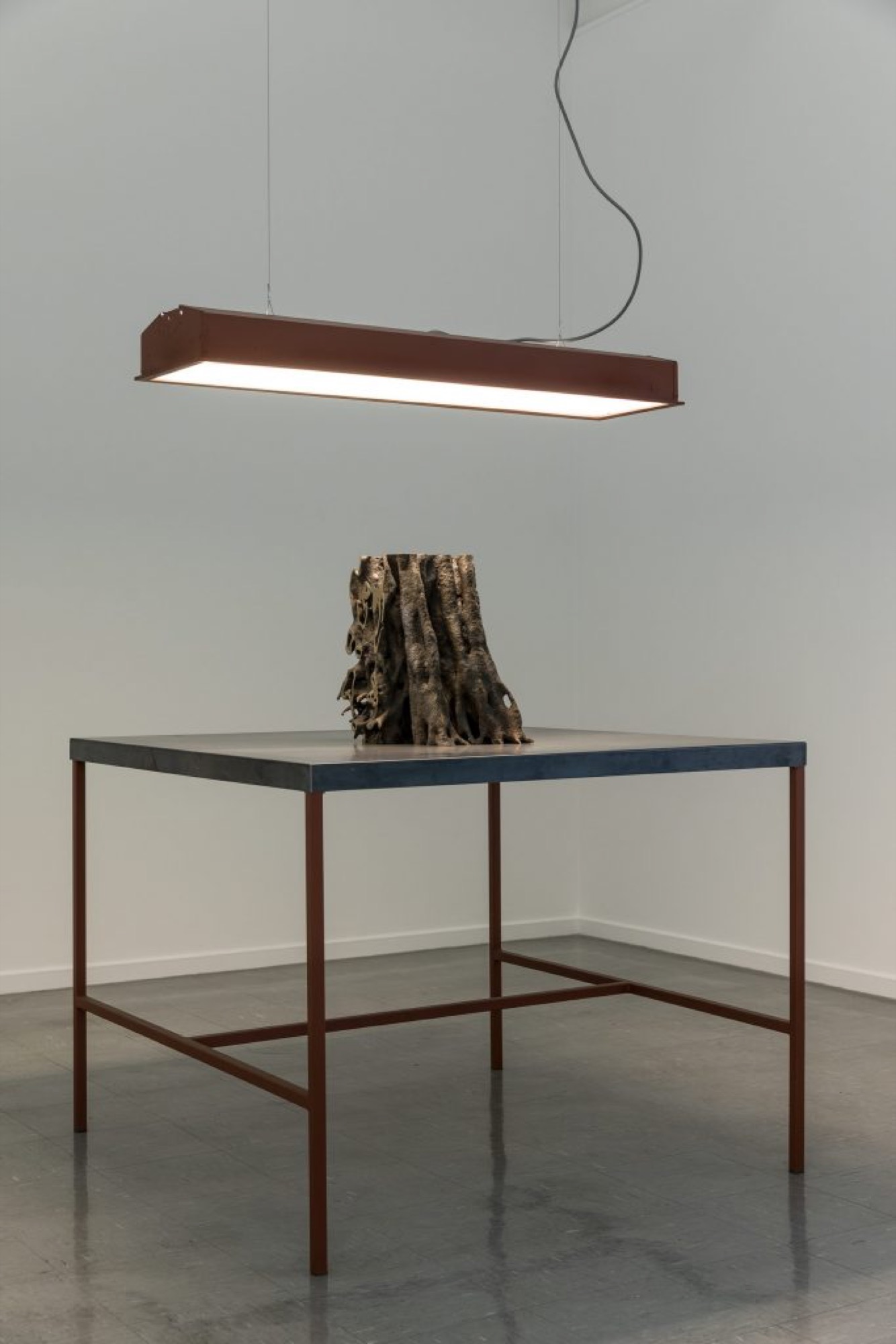
What Mangan’s 3D printed computer models suggest is that not only have nonhuman organisms long been capable of making connections and creating objects and structures akin to art and culture, but that the post-human machines and AIs of the future can too. Termites, like our technological tools, for the most part remain concealed in the background, their presence coming to our attention only after the damage has already been done and our house starts crumbling down. By modelling themselves on insect politics, could it be that increasingly autonomous machines have a better shot at colonising the earth as termites have been doing ever since they dashed alongside the now defunct dinosaurs? Geological deep time and the geoengineered near future fuse into weird biotechnological hybrids that puncture our present Anthropocene with labyrinthian holes leading to the inhuman cultures already teeming all around us, just beneath the surface. It didn’t take intelligent machines long to automate artists out of the job alongside the luddites, but it doesn’t decelerate the process either. No wonder that, with his Frankensteinian experiment Neural Net (slice), Mangan transgresses all research ethics by removing the frontal lobe, the human brain’s control panel responsible for crucial cognitive capacities like language, decision-making and rational judgment. Looking at his cut-up of the human brain into curves akin to cables and tubes as much as reading scientific research in contemporary neuroscience, we are left with the impression that even human logos is not really beholden to a centralised, top-down rationality as much as it, too, emerges from millions of neurons making connections through synapses without any overall governing principle.
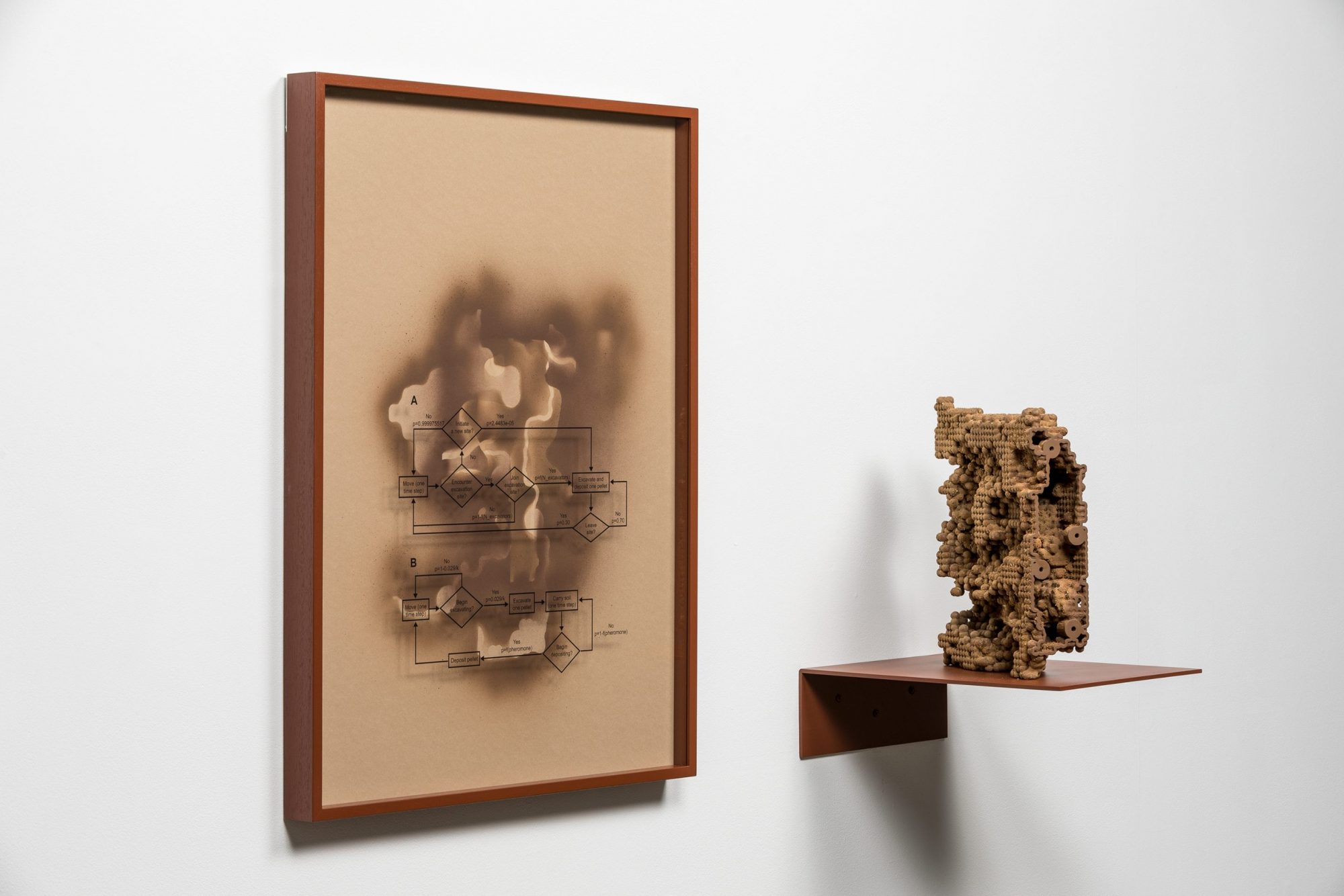
Mangan’s “parallel processing” of algorithms and insects, of bugs and computer bugs, ultimately converges around a vision of cultural systems sprawling forth from the countless connections between dismembered organs without any external control panel consciously piloting the process as a self-professed benevolent dictator. It is what cyberfeminist Sadie Plant calls “the virtual complexity of culture” as “intelligence is no longer monopolized, imposed or given by some external, transcendent, and implicitly superior source which hands down what it knows—or rather what it is willing to share—but instead evolves as an emergent process, engineering itself from the bottom up”. As Plant’s own hive mind, known as the Cybernetic Culture Research Unit, wrote in a fittingly titled cut-up piece called “Swarm Machines”, which sought to subvert all authorial agency in much the same way that Magnan’s Termite Economies series does perhaps even against his own will, there is no longer anyone in control and certainly no transcendence, “only multiplicities, decolonized ants, swarms without strategies, insectoid freeways burrowed through the screens of spectacular time”.
Vincent Le is a catastrophe-drunk philosopher and PhD candidate at Monash University. He has taught philosophy at Deakin University and The Melbourne School of Continental Philosophy. He has published in Hypatia, Cosmos and History, Art + Australia, Šum, Horror Studies and Colloquy, among other journals. His recent work focuses on the reckless propagation of libidinal materialism.


